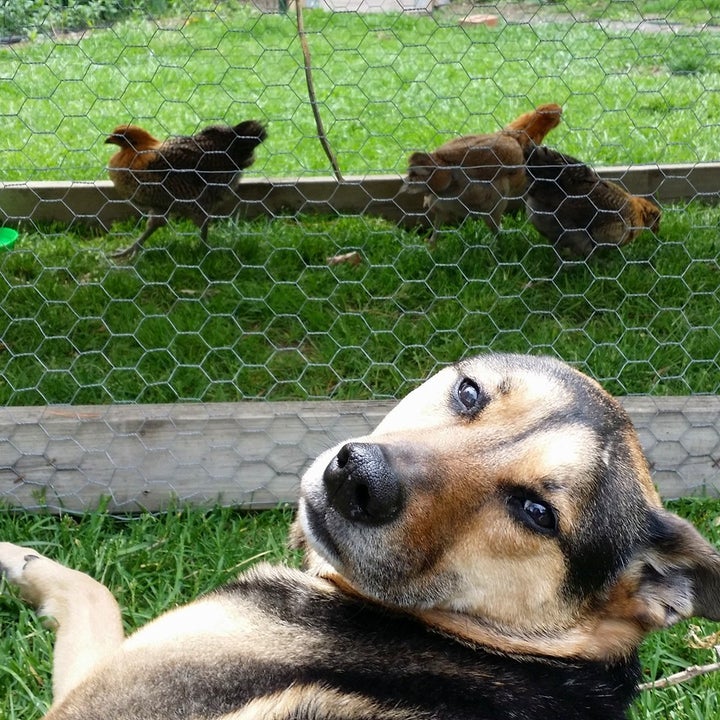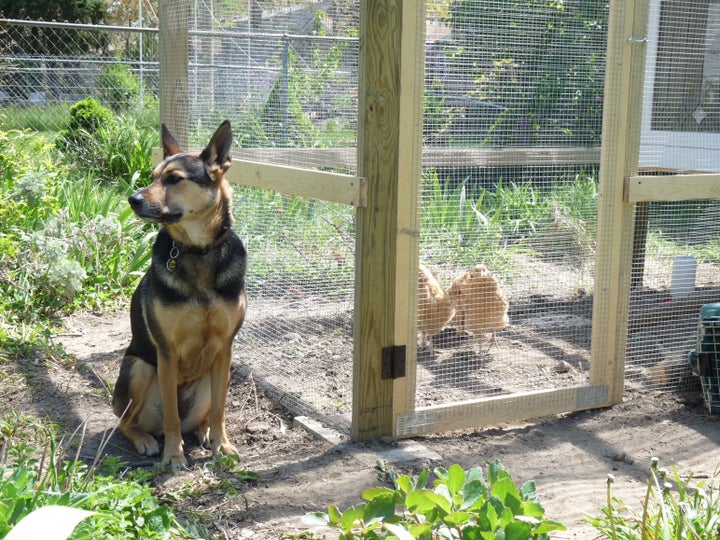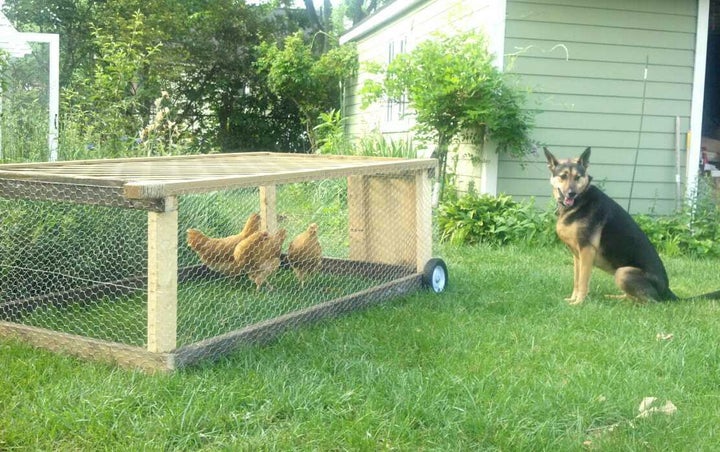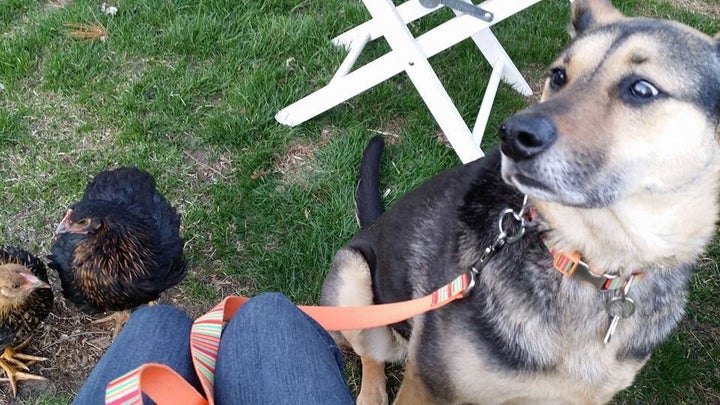Short answer: yes.
Long answer: It all depends on your dog, your patience, and how willing you are to risk the life of your chickens. Your mileage may vary, depending on thoughtful planning and training.

Dogs can coexist with chickens, particularly if they’re exposed to each other at an early age
The first thing you need to consider is how well you know your dog, and how well your dog is trained to know you. Ask and answer these questions to yourself:
- Does my dog love to chase small animals?
- Is my dog reactive to fast moving things?
- Does my dog look to me for guidance?
- Will my dog listen to me and obey even when excited?
- Has my dog shown evidence of high prey drive (chased, hunted, stalked, killed critters)?
- Is my dog a breed that was bred specifically to hunt?
- Am I willing to invest considerable time and resources into preventing my dog from killing my chickens?
- Do I have the patience to change my life and the way I handle my dog?
With the exception of the last two, none are deal-breakers in the assessment of whether you can successfully integrate backyard chickens into your life. Birding and hunting dogs will require an incredible amount of time to train, and might not be trustworthy for a long time- if ever. Even small dogs, like some terriers, can be problematic in training due to their natural instinct to chase and kill small animals. However, even if your dog is a known hunter, you can still build a small flock in your backyard.
Your first tangible step is to build a coop and run, or a sturdy “chicken tractor”, as well as a brooder box. Your coop and run must be constructed in such a way that it can prevent a tenacious dog from reaching your chickens- this means run walls must be hardware cloth, NOT chicken wire (chicken wire is meant to keep chickens in, not other animals out). Chicken tractors are essentially a mobile coop and run, allowing you to move the chickens to various places in the yard with continuous protection. At our home, we opted for both, for one important reason: with a high prey drive dog and the desire to eventually let the birds free range, we felt it would be advantageous for the dog to see the birds in different locations, invading her territory.
Making Introductions Between Your New Chicks and Your Dog
Once you’ve built the brooder box and a coop (mobile or permanent), you’re ready to get your chicks. Bring home your adorable fluffballs, place them in the brooder box, and let your dog listen to the sounds they make. Chances are your dog will be extremely curious, and with your chicks protected this is a perfect time to assess just how reactive your dog is to these new family members. If your dog displays any aggression or shows a lack of restraint (shaking, drooling, lunging, barking, growling, pawing, etc), remove them immediately from where you keep your brooder box. Repeat this exercise daily, allowing your dog to see the chicks in the brooder box and removing them if necessary. The exposure will help desensitize your dog to the sounds, sights, and smells of the chicks.
Desensitization is a slow, laborious process, and you need to prep yourself for incremental steps. Once your dog shows restraint, or simply low to mild interest, you can proceed to riskier endeavors like:
- opening the brooder box while your dog is in the room (do this with a loose leash on your dog, as chicks can and will jump or attempt flight, which might trigger a reaction)
- allowing the chicks to walk in the room, again with your dog on a leash
- holding the chicks and allowing your dog to sniff them (with muzzle, if you have even a remote doubt)
If your dog doesn’t react aggressively or with too much interest, congrats- you’ll likely have a dog that isn’t a chicken killer, and you can start exposing the chicks to the dog without precautions like leashes and muzzles. If your dog shows any aggression at any step, continue desensitization with safeguards in place.

A trustworthy dog is relaxed and only mildly interested in your protected pullets
Moving Interaction Outside
Something about being outside makes dogs behave differently. Dogs that live with indoor cats can be aggressive and reactive with outdoor cats (even if it’s the same cat they saw indoors!), and the same holds true with your new chicks. When the chicks are old enough to spend time outside, start desensitizing your dog again in this new environment. Keep your dog leashed and walk them past the coop run or chicken tractor, or whatever pen in which you’re keeping your chicks safe. Progress to off leash when your dog doesn’t display risky behavior. Don’t be afraid to take a step back if you note any intense interest.

We used a chicken tractor along with the coop and run for purposes of training and desentization
Let your dog see you interact with the chicks outdoors. If you go in to change the water or provide feed, let your dog watch you- from outside the coop run, of course.
One of the best things about this process is that it grows the bond and trust between you and your dog. Your ability to assess your dog, and their trust in your commands, will grow exponentially during this time.
The Final Stage: Allowing Your Chickens Out in the Yard With Your Dog
Once your dog has spent time getting used to seeing the chicks outdoors, you can enter into the final stage of desensitization: allowing the chickens to roam in the yard with your dog, with no protective barrier between them. Start with a leash on your dog, again. Allow the pullets to run, flap, fly, and generally enjoy themselves. Keeping your dog on leash, set up a place to just sit and watch them. If your dog is disinterested, progress to walking them around the yard, ever closer to wherever the pullets are.

Your dog should show little to no interest in the pullets when they are roaming free. Use a loose leash to assess interest, and increase proximity incrementally.
If your dog generally seems bored by this whole ordeal, you’ve succeeded. Take a deep breath, cross your fingers, and let them off leash.
If you’ve assessed properly and taken your time with desensitization, everything will likely go off without a hitch. However, if your dog reacts, simply take steps back. This isn’t a race, and you don’t need to rush it. By the point that leash comes off while your chickens are roaming in the same space as your dog, you should be months into the investment in the relationship between your animals.
Final Thoughts on Keeping Dogs With Chickens
Life isn’t always a bucolic happy ending, and not every dog will be capable of off leash interaction with free ranging chickens. There’s really nothing wrong with that, either. In our case, our lovely American Bulldog was never able to overcome his strong desire to see the chickens with his mouth, not his eyes. Because of that, he was never given the chance to do damage- we either kept him on leash, or kept the chickens behind a barrier when he was out. There are also an abundance of horror stories of dogs who were previously fine with chickens suddenly going berserk and attacking, usually after the chicken ran or flew past them. It’s a real possibility that can’t be ignored.
That said, the vast majority of dogs are fully capable of accepting chickens into their ‘pack’. Ultimately, you will be the deciding factor on a successful outcome, and it all hinges on your willingness to take your time and truly understand how your dog views the newcomers.
Still unsure? Follow our happy hens & even happier dog on Facebook:
